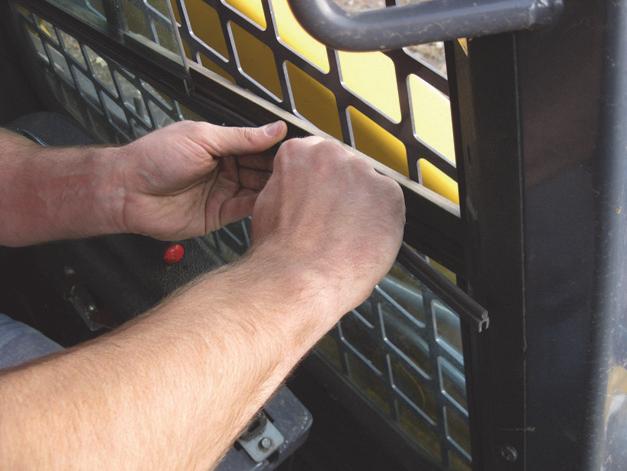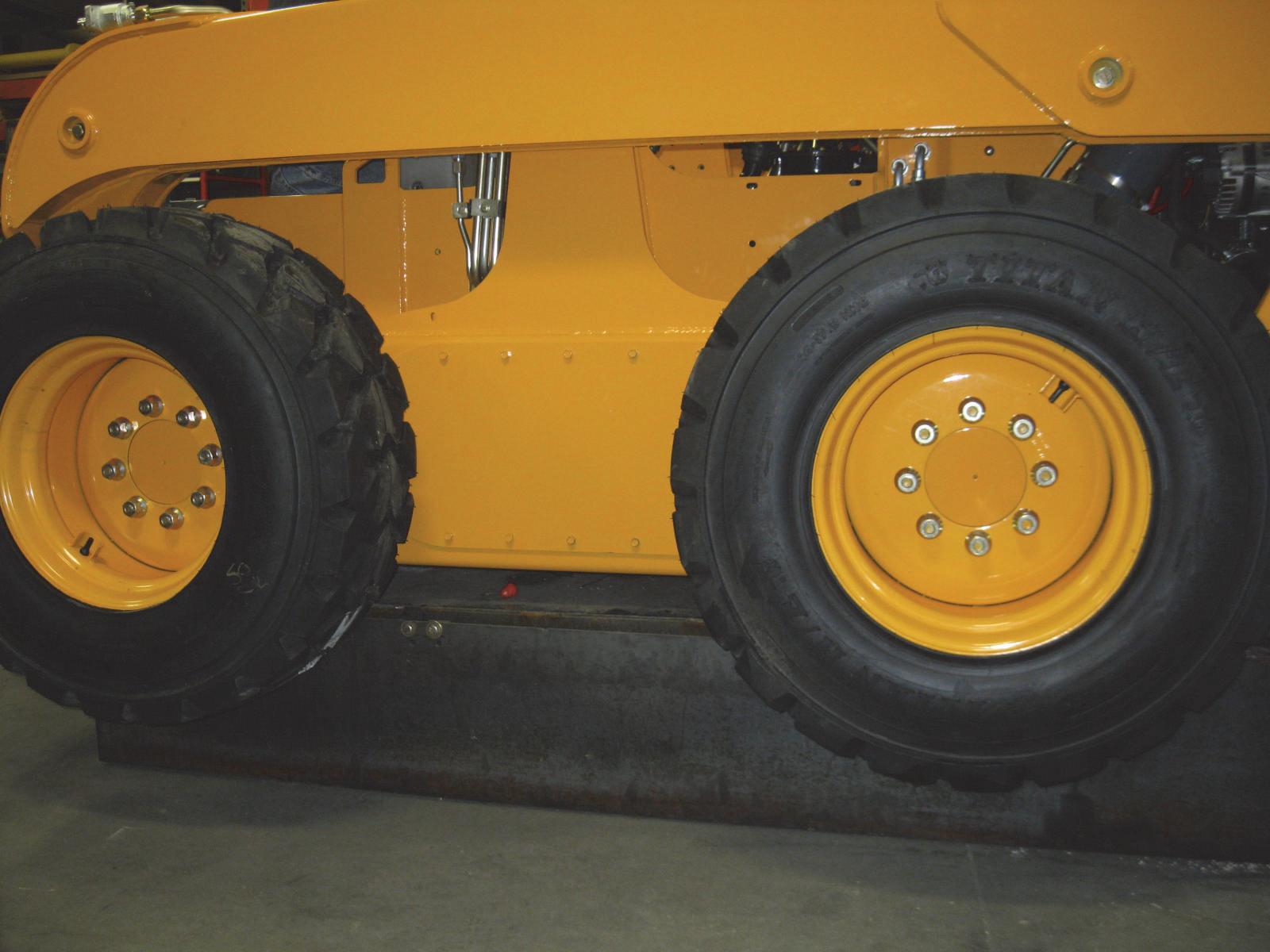
5 minute read
Loader Raising Procedure
To raise the skid-steer loader so all four tires are off the ground, use the procedure below:
Warning
Do not rely on a jack or hoist to maintain the raised position without additional blocking and supports. Serious personal injury could result from improperly raising or blocking the loader.
1.To block the loader, obtain enough suitable blocks (solid wood, hard plastic or metal) so all of the tires are raised off the ground.
2.Using a jack or hoist capable of lifting the fully-equipped weight of the loader (with all attached options), li until the rear tires are off the ground.
3.Stack wooden, hard plastic or metal blocks under the flat part of the loader chassis. They should run parallel with, but not touch, the rear tires.
4.Slowly lower the loader until its weight rests on the blocks. If the tires still touch the ground, raise the loader again, add more blocks and lower again.
5.Repeat steps 2 through 4 for the front end. When the procedure is finished, all four tires are off the ground, so they could be removed.
Loader Lowering Procedure
When service or adjustment procedures are complete, the loader can be lowered from the raised position. To lower the loader onto its tires:
1.Using a jack or hoist, raise the front of the loader until its weight no longer rests on the front blocks.
2.Carefully remove the blocking under the front of the loader.
3.Slowly lower the loader until the front tires are resting on the ground.
4.Repeat steps 1 through 3 for the rear of the loader. When the procedure is finished, all four tires will be on the ground and the blocks removed from under the loader.
Engine Compartment Access
To open the engine compartment, lift the engine cover. Then pull the rear door latch up (Figure33) and carefully swing open the rear door. There is another rear door latch near the top hinge pin of the door to secure the door open.
Additionally, the radiator swings out for service (Figure34). Pull up the spring-loaded latch that secures the radiator to the chassis bumper and place the latch grip in its welded tab placeholder, then pull the radiator outward.
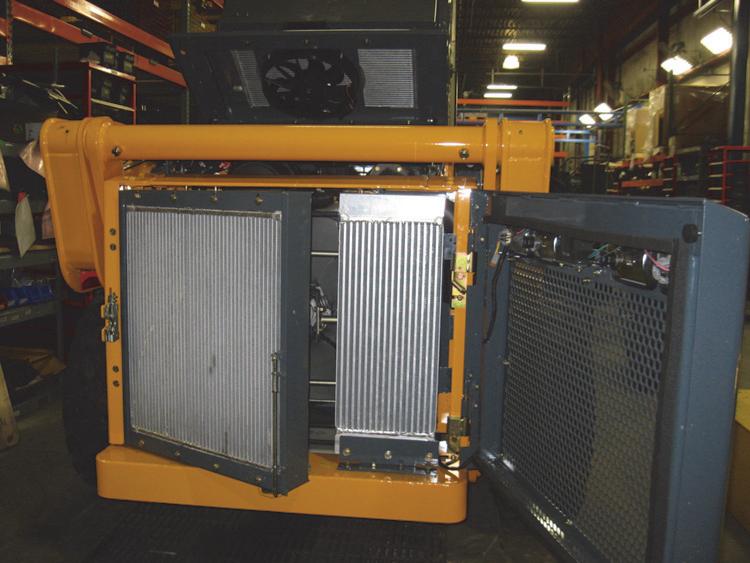

Tilting Back the ROPS/FOPS
A manual lock mechanism is used as a gas spring lock to prevent the raised ROPS/ FOPS from lowering unexpectedly. The manual lock mechanism engages to lock the ROPS/FOPS in a tilted-back position.
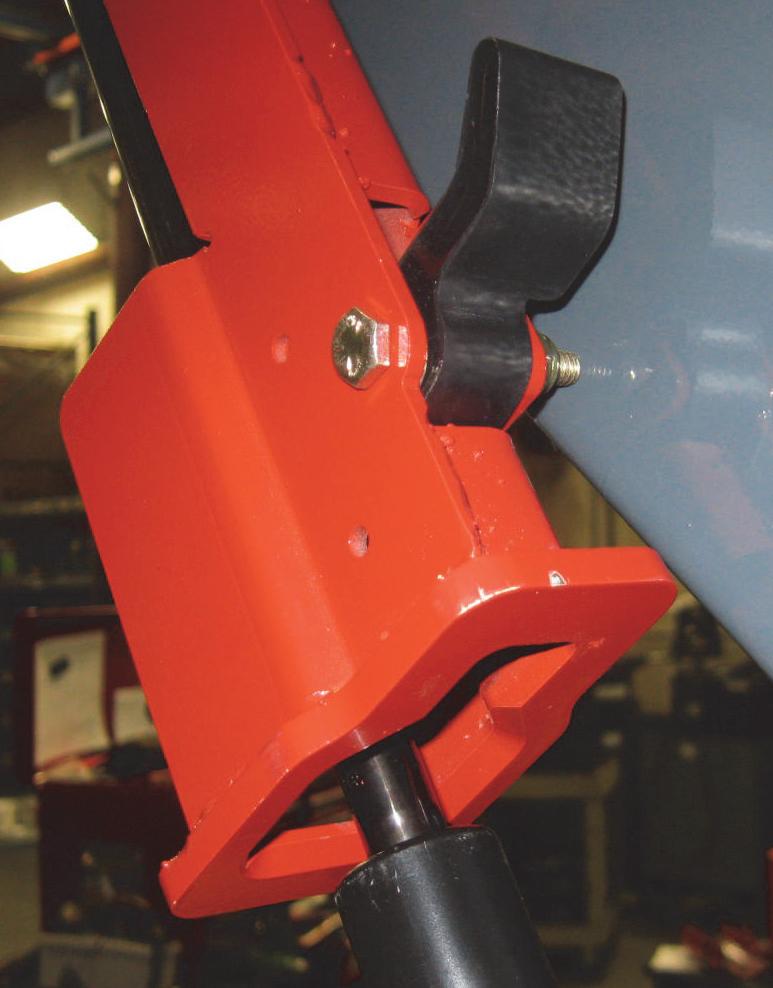
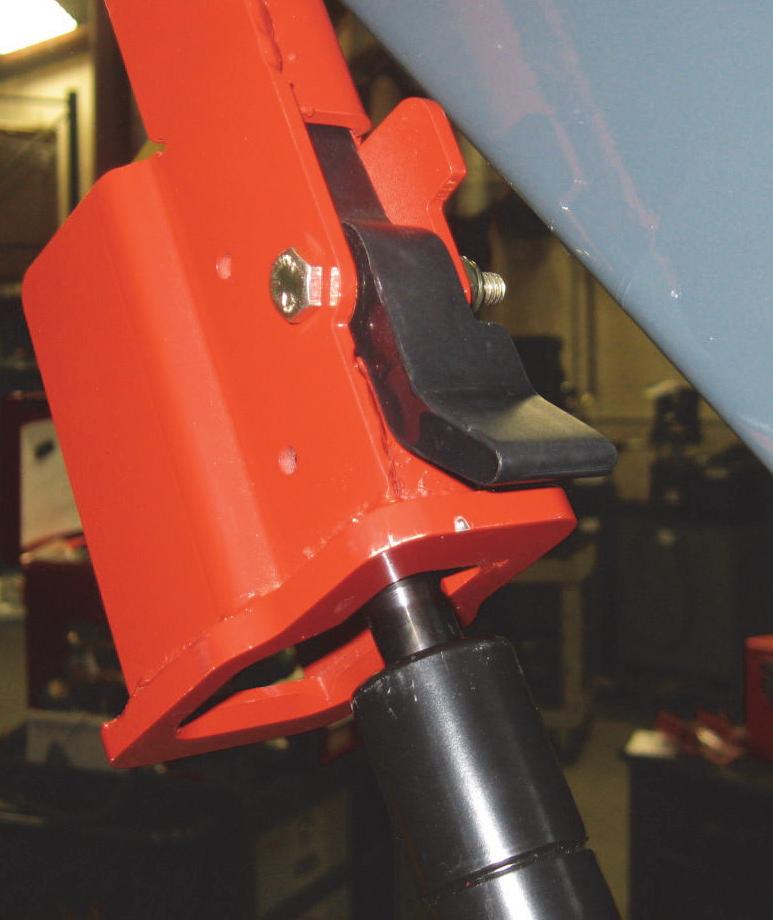
To tilt back the ROPS/FOPS, remove two hex nuts on two anchor bolts at the front of the ROPS/FOPS. Tilt it back slowly, moving the control handles out of the way. Two gas-charged springs help tilt it back. A self-actuating lock mechanism will engage to lock when the ROPS/FOPS is in a rolled-back position. To lower the ROPS/ FOPS, return the lock mechanism to the unlocked position (flipper up). Lower the ROPS/FOPS slowly onto the chassis. Reinstall the anchor bolts, washers and locknuts. Refer to the Torque Specifications chart (page109) for torque information.
Warning
Never operate the loader with the ROPS/FOPS removed or tilted back. Be sure the lock mechanism is securely engaged when the ROPS/FOPS is tilted back. Be sure to reinstall the anchor bolts, washers and locknuts before resuming operation. Additionally, DO NOT raise or lower the lift arm with the ROPS/FOPS rolled back.
Adjustments
Control Handles
The control handles do not require routine adjustment. Refer to the Service Manual for the initial setup procedure.
Removing Foreign Material
The loader should be cleared daily of dirt and other foreign materials in the following areas:
•around the lift cylinders
•at the front of the loader
•on the hitch, especially around tilt cylinder
•around the hydraulic oil reservoir breather
•in the engine compartment
•in the operator’s compartment
Important: Build-up of foreign materials in these areas can interfere with the operation of the loader, cause component damage or become a fire hazard.
Lubrication
Listed below are the temperature ranges and types of lubricants for this machine. Refer to the separate engine manual for more information regarding engine lubricants, quantities and grades required.
Note: Refer to the specific service sections for detailed information on periodic checking and replenishing of lubricants.
Refer to Figure37 for grease fitting locations. Wipe dirt from the fittings before greasing them to prevent contamination. Replace any missing or damaged fittings. To minimize dirt build-up, avoid excessive greasing.
Important: Always dispose of waste lubricating oils and hydraulic fluids according to local regulations or take to a recycling center for disposal. Do not pour onto the ground or down the drain.
SystemLubricant
Hydraulic System Oil
Chaincase Oil
Use Petro Canada HVI60, Mobil DTE 15M or equivalent, which contain anti-rust, anti-foam and anti-oxidation additives, and conforms to ISO VG46.
Entire System Capacity: 24.50 U.S. gallons (92,7 L)
Bare Reservoir Capacity: 16.75 U.S. gal. (63,4 L)
Use SAE grade 15W-40 or 10W-30 motor oil.
Capacity (each side): 15 U.S. quarts (14,2 L)
Grease Fittings Use lithium-based grease.
Important: Refer to the Engine Operator’s Manual for specific engine oil recommendations.
Below 32°F (0°C) – Use SAE Grade* 10W-30
Engine Oil
Above 32°F (0°C) – Use SAE Grade* 15W-40
*Service Classification: API-CI-4
Capacity: 11.75 U.S. quarts (11,1 L)
Figure37 Service Locations
Check Engine Oil Level (page70)
Check Hydraulic Oil Level (page83)
Grease Hitch, Hitch-related Cylinder
Pivots and Latch Pins (page63)
Grease Lift Arm Pins (page63)
Check Oil Level in Chaincases (page65)
Change Engine Oil and Filter* (page70)
Change Hydraulic Oil Filter (page83)
Change Hydraulic Oil (page84)
Change Chaincase Oil (page65)
Check & Drain Water Separator (page71)
Perform the initial procedure at 50 hours, then at the indicated intervals. * Every 500 hours or six months.
Chaincases
There is a chaincase on each side of the loader. Refer to the Maintenance Interval Chart (page99) for change intervals. Refer to the Lubrication chart (page64) for the type of lubricant.



Checking and Adding Oil
1.Park the loader on a level surface and raise the lift arm, refer to the Lift Arm Support Device Engagement Procedure (page22). Shut off the engine and remove the key.
2.At the front of each chaincase and on top of the chaincase there is a fill location underneath a bolt-in cover. Unbolt the cover to access the fill location (Figure38).
3.Prior to checking, the chaincase must be made level from front to back. At the front of the loader are two plugs in the chassis (Figure40). The top plug is the oil level check plug, while the lower plug is the chaincase drain plug.
4.Remove the oil level check plug on the front side of the chaincase to be serviced. The oil level should be no more than 3/4 in. (19 mm) below it.
5.If the oil level is low, add oil through the fill plug until the oil level is no more than 3/4 in. (19 mm) below the check plug hole. Reinstall the plugs.
Draining Oil
1.Park the loader on a level surface, or on a sloping surface with the loader facing downhill and the tires blocked.
2.Remove the chaincase drain plug on each chaincase and drain the oil into a suitable container.
3.Reinstall and tighten the drain plugs.
4.Refill the chaincases at the fill plugs per the procedure above.
Drive Chains
Drive chains are located in the chaincase on each side of the machine. Refer to the Maintenance Interval Chart (page99) for tension check interval.
Checking Chain Tension
1.Raise the loader following the Loader Raising Procedure (page59).
2.Rotate each tire by hand. The proper amount of chain defection should be 1/8 inch to 1 inch (3 to 25 mm) forward and rearward tire movement. If the chain defection is more than 1inch (25 mm) or less than 1/8 inch (3 mm) in either direction, the chains should be adjusted.
Adjusting Chain Tension
1.Raise the loader following the Loader Raising Procedure (page59).
2.Remove the tire from the axle to be adjusted.
3.Loosen (but DO NOT remove) the bolts holding the axle to the chaincase.
4. Front Chain Tension – To tighten the front chain, move the front axle assembly toward the front of the loader. To loosen the chain, move the front axle assembly toward the rear of the loader.
Rear Chain Tension – To tighten the rear chain, move the rear axle assembly rearward. To loosen the chain, move the rear axle assembly toward the front of the loader.
5.After proper tension is achieved, retighten the bolts.
Important: Be careful not to over-tighten the drive chains. Over-tightening will cause premature drive chain and axle sprocket wear.
6.Reinstall the tire.
7.Repeat steps 2 through 6 for any other axle requiring adjustment.
8.Lower the loader following the Loader Lowering Procedure (page60).

